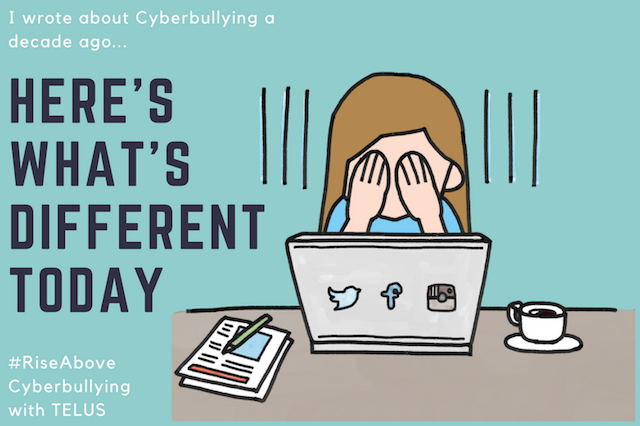I Wrote About Cyberbullying a Decade Ago: Here’s What’s Different About This Problem Today
In 2008 I wrote a blog post about cyberbullying. My blog was 4 years old at the time, and at least once a week I would get an anonymous comment saying that I, or something I wrote about, was stupid. I never knew who wrote the comments, nevertheless I had a weekly reminder from someone, somewhere, that what I was doing wasn’t worth anything. My husband would say: “Do you know this person? Do you really care what they have to say?” I would wipe away some tears, nod, and agree that I shouldn’t let this bother me.
Then it got worse. I could see people on social media actually talking about me.

In my 2008 post I wrote: “Unfortunately these malicious acts don’t stop after childhood and the practice of seeking joy by belittling and intimidating someone has changed since I was in school. The new forms of communicating these ill-willed attacks are through blogs, Facebook pages, MySpace, text messages, and forum posts. Probably one of the worst parts is that you might not even know who the aggressor may be.”
That changed.
Soon, social media accounts became far more personal. Trolls used their real names, their real professional accounts, and still made fun of me. Some even wished me physical harm, simply because they didn’t like what I blogged about — I’m still not sure how walks in Stanley Park and a post about the farmers market could be so offensive. That’s what hurt the most. I knew who was doing it, and I was a 20-something adult. I couldn’t imagine this happening to someone much younger, on an even more personal level.
What’s Different Today
Would you like the good news or the bad news first? There are two ways that cyberbullying and bullying are different for kids today.
The good news is that we’re now more connected than ever, sending and receiving more of ourselves through personalized messages, social media posts and photos. We can instantly look up or post a review, search for an answer to a question, or see what our friends are doing.
The bad news is that this connectivity goes beyond constant updates and being informed — you’re putting yourself out there with everything you post. You want to show your personality and share with friends. We’re always told to be ourselves, but how much is too much sharing? At what point do we lose hold of our updates, our message, our voice?
The difference between 10 years ago and today is that today, it’s personal. Cyberbullying attacks are no longer just from anonymous trolls, using a fake name and email address. They’re from actual people, you actually know, using their real names, and you probably see them at school every single day, and they know it.
Perpetrators no longer hide behind a computer screen. They take your information, they take what makes you vulnerable, and they want everyone to know they have it. It’s an incredibly powerless and hopeless feeling, and it hurts even more knowing who is doing the damage.
What’s changed now, is that there are online tools that can help. Rise Above is part of TELUS’ ongoing commitment to improving the lives of youth and their communities to help make digital spaces safe places for everyone. They have resources available online for teachers, students, and parents. That’s really good news.
Some of my favourite insights are:
- When you react to cyberbullying, you can turn things around. Witnesses have tremendous power in turning cyberbullying situations around. But to make this happen, you need to take action.
- Ask yourself: Am I letting things go because I don’t think I can do anything to help? Actually, what you do is super important. What witnesses do about bullying is actually one of the most important factors in how much someone is hurt by it and can go a long way in building positive online spaces.
- Comfort the person who is being targeted privately. One of the worst things about being bullied is feeling that nobody cares about what’s happening. Letting someone know you care can be a big help and won’t make things worse.
For parents, these resources offer advice and answer some big questions like: How do I know if my child is being cyberbullied? What should I do if my child is targeted? And much more.
Cyberbullying has changed a lot in the past 10 years, with the accessibility of social networks, sharing and engagement habits. Even if you have not experienced it first hand, you’ve probably come across bullying at the workplace, school, or in your community. While our exposure has been augmented, so have the resources that can aid our discussions, which can be key to dealing with this issue.
RiseAbove with TELUS
Visit TELUS.com/RiseAbove to find resources to help empower youth to stand up to cyberbullying.










